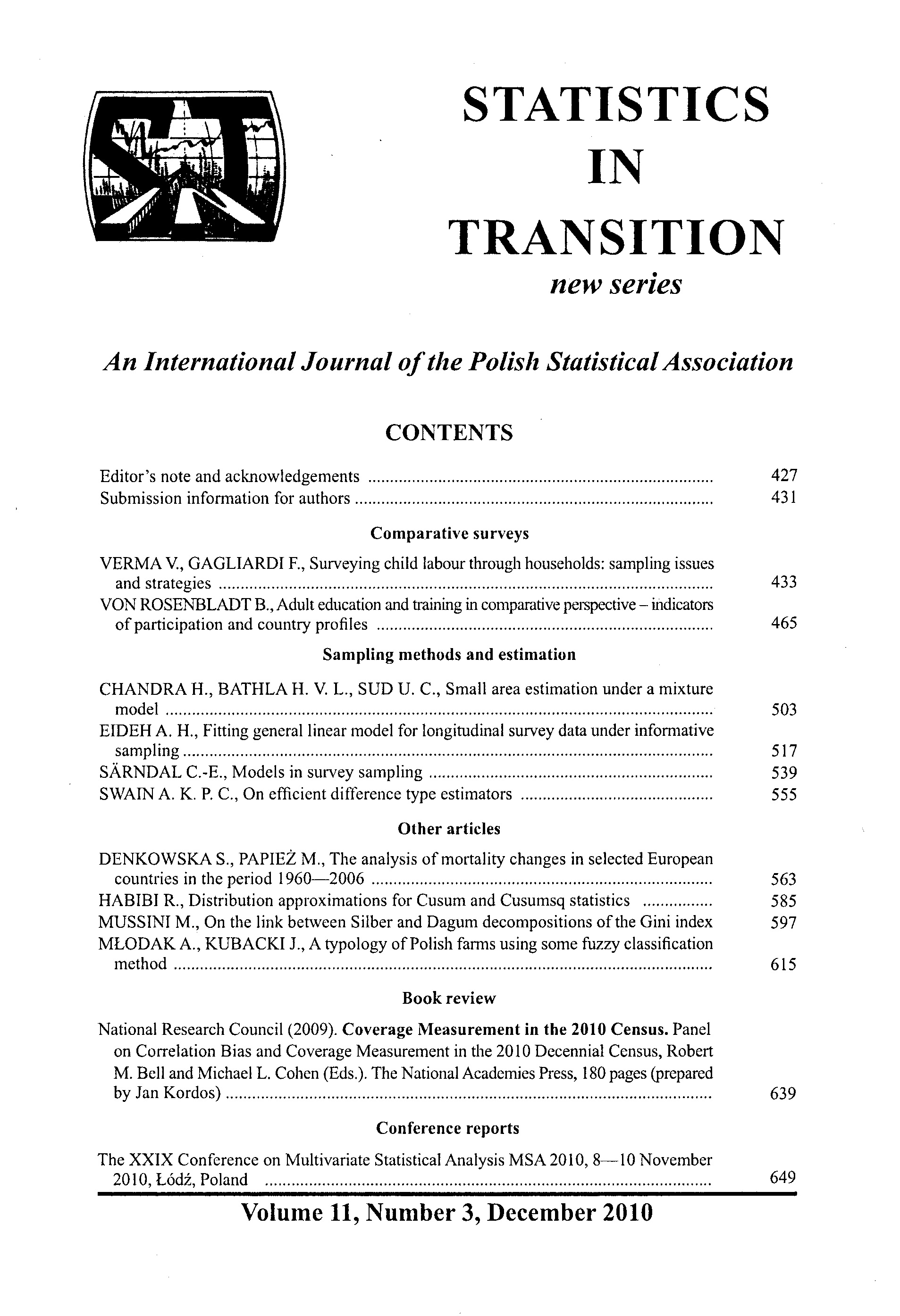ARTICLE
ABSTRACT
Small area estimation (SAE) under a linear mixed model may not be efficient if data contain substantial proportion of zeros than would be expected under standard model assumptions (hereafter zero-inflated data). We discuss the SAE for zero-inflated data under a mixture model (Fletcher et al., 2005 and Karlberg, 2000) that account for excess zeros in the data. Our results from simulation studies show that mixture model based approach for SAE works well and produces an efficient set of small area estimates. An application to real survey data from the National Sample Survey Organisation of India demonstrates the satisfactory performance of the approach.
KEYWORDS
Linear mixed model, Small area estimation, EBLUP, Zero-inflated data, mixture model.
REFERENCES
BRESLOW, N. E. and CLAYTON, D. G. (1993). Approximate Inference in Generalized Linear Mixed Models. Journal of the American Statistics Association, 88, 9-25.
CHANDRA, H. and CHAMBERS, R. (2006). Multipurpose Weighting for Small Area Estimation. Journal of Official Statistics, accepted for publication.
CHANDRA, H., SALVATI, N. and CHAMBERS, R. (2007) Small Area Estimation for Spatially Correlated Populations. A Comparison of Direct and Indirect Model-Based Methods. Statistics in Transition, 8, pp. 887-906.
FLETCHER, D., MACKENZIE, D. and VILLOUTA, E. (2005). Modelling Skewed Data With Many Zeros: A Simple Approach Combining Ordinary and Logistic Regression. Journal of Environmental and Ecological Statistics, 12 (1), 45-54.
HENDERSON, C.R (1953). Estimation of Variance and Covariance Components. Biometrics, 9, 226-252.
JIANG, J. and LAHIRI, P. (2006). Estimation of Finite Population Domain Means: A Model-Assisted Empirical Best Prediction Approach. Journal of the American Statistical Association, 101, 301-311.
KARLBERG, F. (2000). Survey Estimation for Highly Skewed Populations in the Presence of Zeroes. Journal of Official Statistics, 16, 229-241.
LAMBERT, D. (1992). Zero-Inflated Poisson Regression, With An Application To Defects in Manufacturing. Technometrics, 34, 1-14.
MCCULLAGH, P. and NELDER, J.A. (1989) Generalized Linear Models (New York: Chapman and Hall)
MANTEIGA, G.W., LOMBARDIA, M.J., MOLINA, I., MORALES, D., and SANTAMARIA, L. (2007). Estimation of the Mean Squared Error of Predictors of Small Area Linear Parameters under a Logistic Mixed Model. Computational Statistics & Data Analysis, 51(5): 2720-2733.
PRASAD, N.G.N. and RAO, J.N.K. (1999). On Robust Small Area Estimation Using a Simple Random Effects Model. Survey Methodology, 25, 67-72.
RAO, J.N.K. (2003). Small Area Estimation. Wiley, New York.
SAEI, A. and CHAMBERS, R. (2003). Small Area Estimation under Linear and Generalized Linear Mixed Models with Time and Area Effects. Methodology Working Paper No. M03/15. University of Southampton, UK.
WELSH, A.H., CUNNINGHAM, R.B., DONNELLY, C.F., and LINDENMAYER, D.B. (1996). Modelling the Abundance of Rare Species: Statistical Models for Counts with Extra Zeros. Ecological Modelling, 88, 297-308.
